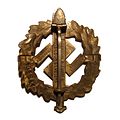SA sports badge
The SA sports badge , later renamed the SA military badge , served in the time of National Socialism as an award for men who were active in sports according to the National Socialist ideology to "improve public health ".
The badge is one of the anti-constitutional propaganda means in Germany . Its creation, public carrying or distribution is forbidden and punishable.
In National Socialism
There are 1,052,661 known awards up to February 1937. The badge was awarded in bronze, silver and gold. These three grades were not dependent on the age of the acquirer, but rather were defined by the work to be performed. It could be reclaimed if the carrier did not behave in accordance with the National Socialist ideal. The badge was donated by Adolf Hitler on November 28, 1933. On January 19, 1939, Hitler renamed it the SA military badge by decree , which expresses its main educational task even more clearly. The badge thus changed from a sports badge to a badge of achievement. Wearing the old badges was forbidden from then on.
Acquisition
The acquisition of the badge was tied to membership in the SA until 1935 , on February 18, 1935 Hitler decided that it could also be acquired and worn by non-SA members. However, if the training was not completed within the SA, it had to be completed in certain "off-road sports working groups" under the control of the SA. The applicant had to be between 18 and 35 years old and, according to the National Socialist ideal, be “worthy of military service”. He had to have been found fit for military service by a medical examination and had to be able to prove his training by a training license holder. The training had to be certified by an SA leader with examination authorization.
In contrast to the bronze badge, which was an actual sports award, the silver and gold variants were badges, the receipt of which was linked to regular repetitive exercises.
exams
The performance test comprised three groups: physical exercises (ie athletics ), (military) basic exercises and cross-country sports. The individual groups were divided into the following exercises:
Group I physical exercises
- Exercise 1: 100 m run,
- Exercise 2: long jump with run-up,
- Exercise 3: Shot put (7¼ kg), with an arm from a circle 2.13 m in diameter,
- Exercise 4: throwing a club (500 g) as a core throw and
- Exercise 5: 3000 m run.
Group II basic exercises
- Exercise 6: 25 km baggage march,
- Exercise 7: Small-bore shooting 50 m, lying down, laid down,
- Exercise 8: Small bore shooting 50 m, prone, hands-free,
- Exercise 9: club target throw (500 g); 10 m lying, 20 m kneeling, 30 m standing in a circle 4.0 m in diameter
(Note: The club has a similar shape to the stick hand grenades used by the Wehrmacht )
Group III off-road sports
- Exercise 10: Terrain Vision; ie recognize targets ("head disks") on different. Distances,
- Exercise 11: Orientation; i.e. use of map and compass,
- Exercise 12: Terrain assessment, "to be assessed for the approach of a patrol",
- Exercise 13: Reporting; ie reproduce an oral message (about 15 words, a time, two place names, a number) after a distance of 600 m or 5 minutes
- Exercise 14: camouflage
- Exercise 15: Estimating distances (up to 100 m, 100–400 m, 400–800 m and laterally 200 m with max. 30% deviation) and
- Exercise 16: Land use; ie movement within the scope of an order
- In addition, (17.) the general off-road behavior during the test (conception, dexterity, freshness and determination) was assessed.
While the exercises in Group I essentially correspond to the requirements of a sports badge, the pre-military training character in Groups II and III is very clear. Group III could only be completed after successfully completing Groups I and II. For each exercise in groups I and II, a specific point system was set, as was a fixed number of points for group III.
Different types
The badges are assigned to several types in chronological order according to the property assignments, which differ in their different embossing:
Type 1 was issued from March 1934 to January 1935 with a matriculation number and the embossing “Property d. Bosses d. Training system ”. From February 1935 to December 1938, Type 2 was used, initially with a matriculation number, later without, and embossed “Property d. SA. Sports Badge Hauptstelle ”, issued. Type 3, from January 19, 1939, was stamped “Property of the highest SA leadership”. Type 4 had the embossing "RZM" (for Reichszeugmeisterei ), serial number M1 and the manufacturer number.
Special forms of the badge were the SA sport badge (sea sport) from 1934 to 1935 with an anchor and the SA military badge for war disabled from 1943 to 1945 with wolf tang under the crossguard. Both special forms were aimed at a specific group of applicants and were awarded according to different regulations.
Today: Anti-Constitutional Badge
The SA sports badge or SA military badge is one of the National Socialist awards, the use of which is not permitted in Germany under the law on titles, medals and decorations of July 26, 1957.
swell
- Annual calendar 1935 of the Reichsbund der Deutschen Officials. (RDB), pp. 40-43. (Official statement)
- SA sports badge performance book 1936.
- The way to the SA sports badge. Implementation and examination regulations. German Empire 1936.
Web links
- Verfassungsschutz.de: Right-wing extremism: Symbols, signs and prohibited organizations (PDF) ( Memento from January 16, 2015 in the Internet Archive )
Individual evidence
- ^ Criminal Code: § 86a Use of symbols of unconstitutional organizations , on: dejure.org
- ^ Kurt-Gerhard Klietmann : Verl. "Die Ordens-Sammlung", Berlin 1971, p.



